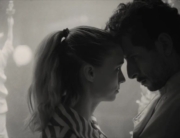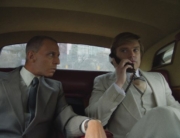Lovelace dramatically takes the Rashomon approach to the pop culture phenomenon that was the 1972 porn flick Deep Throat and its 22-year-old star, billed as Linda Lovelace. While the first half familiarly celebrates the mainstreaming of porn within the sexual revolution (mostly from the male perspective), the second half grimly, and much more revealingly, pops the party balloon by taking seriously the real woman behind the stage name, whose exposé of abuse pushed her into a much different role: feminist anti-porn crusader.
The conventional timeline depicts a young, sweet-faced Linda Boreman (Amanda Seyfried), newly moved from Yonkers to Florida to start a new life after her rigidly repressive parents, Dorothy (a completely disguised Sharon Stone) and John (Robert Patrick), made her give up a baby for adoption. She’s encouraged by her bolder friend Patsy (Juno Temple) to lose her inhibitions in a roller rink and go out with older guys, namely the attentive, sports-car driving bar owner Chuck Traynor (Peter Sarsgaard).
He offers her exciting liberation and romance, and he especially enjoys teaching her new oral sex techniques. Six months later, he’s in financial difficulties, so he brings Linda, now his wife, to two quickie porn producers, real-life Butchie Peraino (Bobby Cannavale) and his gangster-ish investor, amalgamated character Anthony Romano (Chris Noth). They see her as the ticket to bring to life the scheme of director Jerry Damiano (Hank Azaria): a hardcore porn movie with a storyline. Linda is nervous, but she’s relaxed into partying by nonchalant co-stars Dolly (Debi Mazar) and Harry Reems (Adam Brody) during the 17-day shoot.
The cast and crew of the porn phenomenon enjoy the publicity, which explodes into an international, mainstream sensation, as documented in Fenton Bailey and Randy Barbato’s Inside Deep Throat (2005). From Las Vegas to the Playboy Mansion, these small-time folks capitalize on this fleeting fame. They intersect with big-time celebrities, including cameos by James Franco as a sleazy Hugh Hefner, all with Linda sweetly agreeing to do whatever Traynor proffers. Deep Throat reportedly grossed $600 million, not that Linda ever saw any of the money. Lovelace‘s cast is clearly having a great (R-rated) time in period wigs, outfits, and dance moves, looking a lot how the porn industry was portrayed in Paul Thomas Anderson’s Boogie Nights (1997).
Six years later, Linda faces a publisher’s polygraph operator (Eric Roberts) because the memoir she wants to publish so counters the public impression of her as the face of X-rated, liberated sex. Her actual biography is considerably darker, with Traynor manipulating her even more so with drugs, beatings, control, and a gun to her head. Sarsgaard has played a creepy, even violent, manipulator before, but he’s really disturbingly villainous here. When she reaches out to her parents, their attitude, particularly her very cruel mother’s, is that she owes her husband complete obedience and loyalty. Her mother’s first response when Linda reveals that Traynor beats her: “What did you do to make him angry?”
The most effective scene in showing how those around her chose to turn a blind eye to the abuse is seen during the Deep Throat filming. As Traynor beats her in a hotel room, the camera moves further and further out to where the partying cast and crew can overhear them. Uneasy, they presume it’s just the sounds of very rough sex play, and they shrug it all off to go back to their own games—even when make-up has to cover her bruises the next day. (It was the producer who finally got fed up with Traynor and helped her get away from his clutches.)
As upsetting as that is, the script by Andy Bellin (whose Howl was also directed by Rob Epstein and Jeffrey Friedman) leaves out much of Traynor’s earlier brutality as her pimp that she frankly detailed in her memoir Ordeal in 1980. Though the directors thank Gloria Steinem for her insight into how Linda was victimized into participating (she wrote a preface to Linda’s 1986 memoir Out of Bondage), the directors have said they wanted to concentrate more on the contradiction between the public perception of her pleasure in Deep Throat vs. her private horror. The filming of Deep Throat was a short period of her nightmare.
That contradiction is at the heart of the too-brief closing scenes showing the skeptical reactions to her memoir at the cusp of our tell-all, reality TV culture that wasn’t yet used to such exposés, when female audience members question her in a reenactment of her appearance on The Phil Donahue Show. With the film’s emphasis on her reconciliation with her parents, there is only the implication of her testimony to 1980’s anti-pornography commissions and her public lectures, which are referred to in the final scroll and associated her with stridently prudish politics rather than for her own psychological damage from domestic violence. Since Linda’s death in a car accident 30 years after Deep Throat, Seyfried’s sensitively convincing and sympathetic performance helps rebalance the record towards Linda’s trauma and redemption.







Very well written review, Nora!